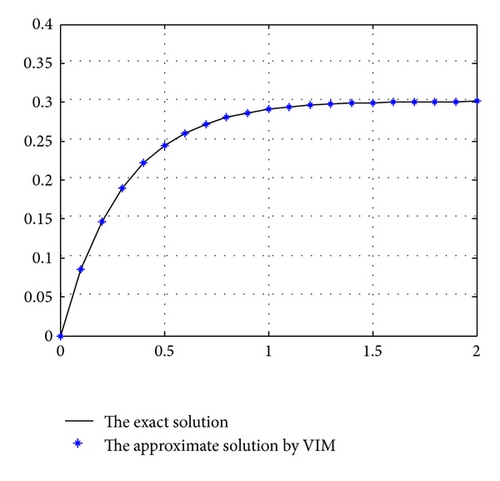Variational Iteration Method for the Magnetohydrodynamic Flow over a Nonlinear Stretching Sheet
Abstract
The variational iteration method (VIM) is applied to solve the boundary layer problem of magnetohydrodynamic flow over a nonlinear stretching sheet. The combination of the VIM and the Padé approximants is shown to be a powerful method for solving two-point boundary value problems consisting of systems of nonlinear differential equations. And the comparison of the obtained results with other available results shows that the method is very effective and convenient for solving boundary layer problems.
1. Introduction
It is well known that most of the phenomena that arise in mathematical physics and engineering fields can be described by partial differential equations. Recent advances of partial differential equations are stimulated by new examples of applications in fluid mechanics, viscoelasticity, mathematical biology, electrochemistry, and physics. There are many traditional and recently developed methods to give numerical and analytical approximate solutions of nonlinear differential equations such as Euler method, Runge-Kutta method, Taylor series method, Adomian decomposition method [1], Variational iteration method [2, 3], Hankel-Padé method [4], DTM-Padé method [5], homotopy perturbation method [6], and Hamiltonian method [7].
In this paper, we consider the model proposed by authors in [1] describing the problem of the boundary layer flow of an incompressible viscous fluid over a nonlinear stretching sheet. The boundary layer flow is often encountered in many engineering and industrial processes. Such processes include the aerodynamic extrusion of plastic sheets, hot rolling, glass fiber production, and so on [1, 4, 5]. And various aspects of the stretching flow problem were discussed by various investigators. Chiam [8] analyzed the MHD flow of a viscous fluid bounded by a stretching surface with power law velocity. He presented the numerical solution of the boundary value problem by utilizing the Runge-Kutta shooting algorithm with Newton iteration. Here, we aim to solve the MHD flow caused by a sheet with nonlinear stretching. The approximate solution of the nonlinear problem is obtained by the variational iteration method.
The variational iteration method [2] is a type of Lagrange multiplier method to find analytical solutions. The method gives the possibility to solve many kinds of non linear equations. In this method, general Lagrange multipliers are introduced to construct correction functional for the problems. The multipliers can be identified optimally via variational theory. It has been used to solve effectively, easily, and accurately a large class of nonlinear problems with approximation [9].
2. Basic Idea of the VIM
3. Problem Statement and Governing Equations
4. Approximate Solution by the VIM
It is evident that the main problem for solving (21) is to obtain the value of f′′(0), then we can resort to any numerical integration routine to obtain the solution of the problem. For this purpose, we will employ the Padé method to determine this unknown value with high accuracy.
5. Padé Approximation
It is well known that Padé approximations [12] have the advantage of manipulating the polynomial approximation into a rational function of polynomials. This manipulation provides us with more information about the mathematical behavior of the solution. Besides that, power series are not useful for large values of η, say η = ∞. This can be attributed to the possibility that the radius of convergence may not be sufficiently large to contain the boundaries of the domain. Therefore, the combination of the series solution through the decomposition method or any other series solution method with the Padé approximation provides an effective tool for handling boundary value problems on infinite or semi-infinite domains. Furthermore, it is noted that Padé approximants can be easily evaluated by using Matlab.
| M | β = −1.5 | β = 1.5 | β = 5 | |||
|---|---|---|---|---|---|---|
| VIM | ADM [1] | VIM | ADM [1] | VIM | ADM [1] | |
| 1.0 | −0.6530 | −0.6532 | −1.5253 | −1.5252 | −2.1529 | −2.1528 |
| 5.0 | −2.0852 | −2.0852 | −2.5162 | −2.5161 | −2.9414 | −2.9414 |
| 10 | −3.0562 | −3.0562 | −3.3663 | −3.3663 | −3.6957 | −3.6956 |
| 50 | −7.0239 | −7.0239 | −7.1647 | −7.1647 | −7.3256 | −7.3256 |
| 100 | −9.9667 | −9.9666 | −10.0776 | −10.0776 | −10.1816 | −10.1816 |
| 500 | −22.3458 | −22.3457 | −22.3905 | −22.3904 | −22.4426 | −22.4425 |

Substituting (21) and the value of f′′(0) into (8), we can easily obtain the second-order approximate solution of (3)-(4).
6. Conclusion
In this paper, the variational iteration method is used to obtain approximate solutions of magnetohydrodynamics boundary layer equations. The analytical solutions of the governing nonlinear boundary layer problem are obtained. Without using the Padé approximation, the analytical solution that were obtained by the VIM cannot satisfy the boundary condition at infinity f′(∞) = 0. The combination of the VIM and the Padé approximants is shown to be a powerful method for solving two-point boundary value problems consisting of systems of nonlinear differential equations. And the obtained solutions are in good agreement with exact values.
Acknowledgments
The work described in this paper was fully supported by a grant from the Research Grants Council of the Hong Kong Special Administrative Region, China (CityU 116308) and Natural Science Foundation of the Jiangsu Higher Education Institutions of China (Grant no. 12KJB130002).




